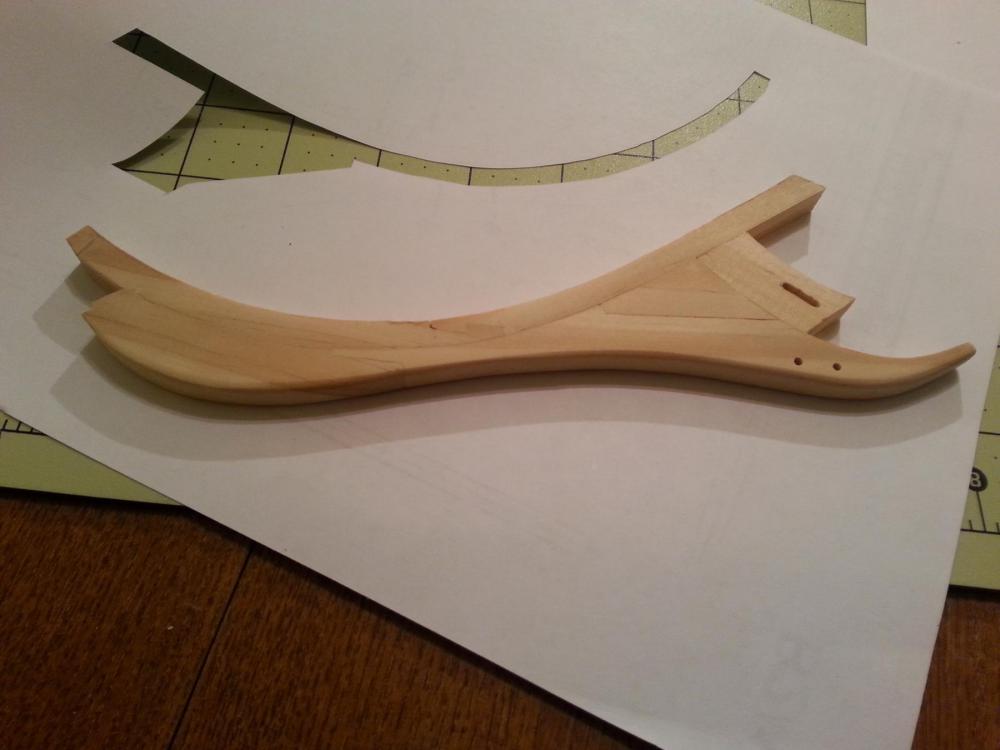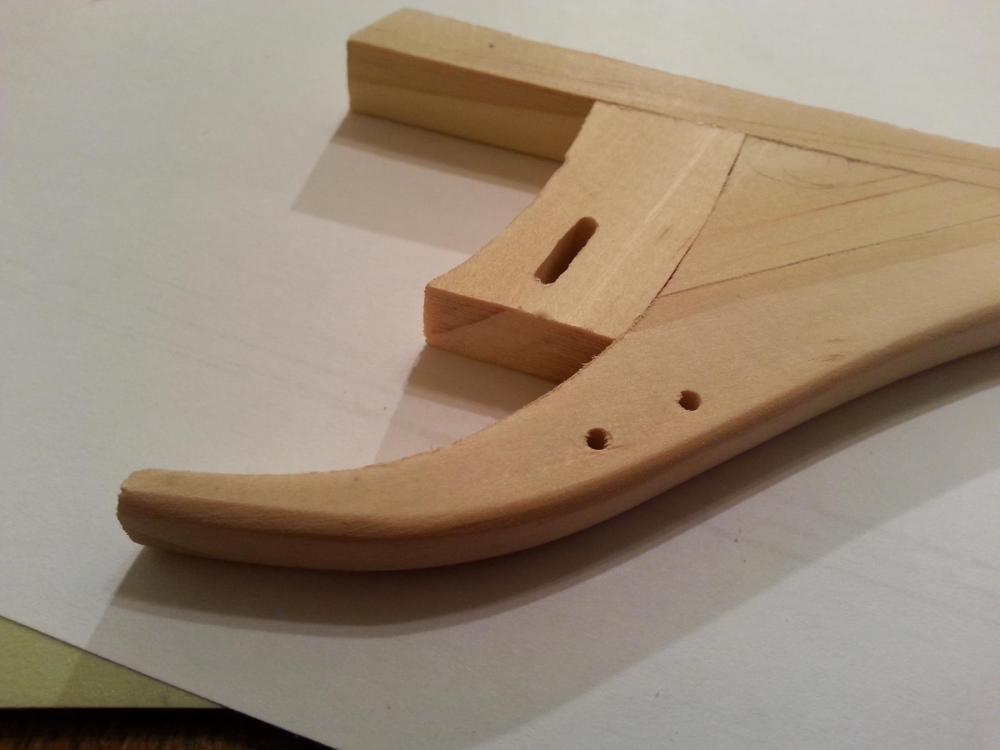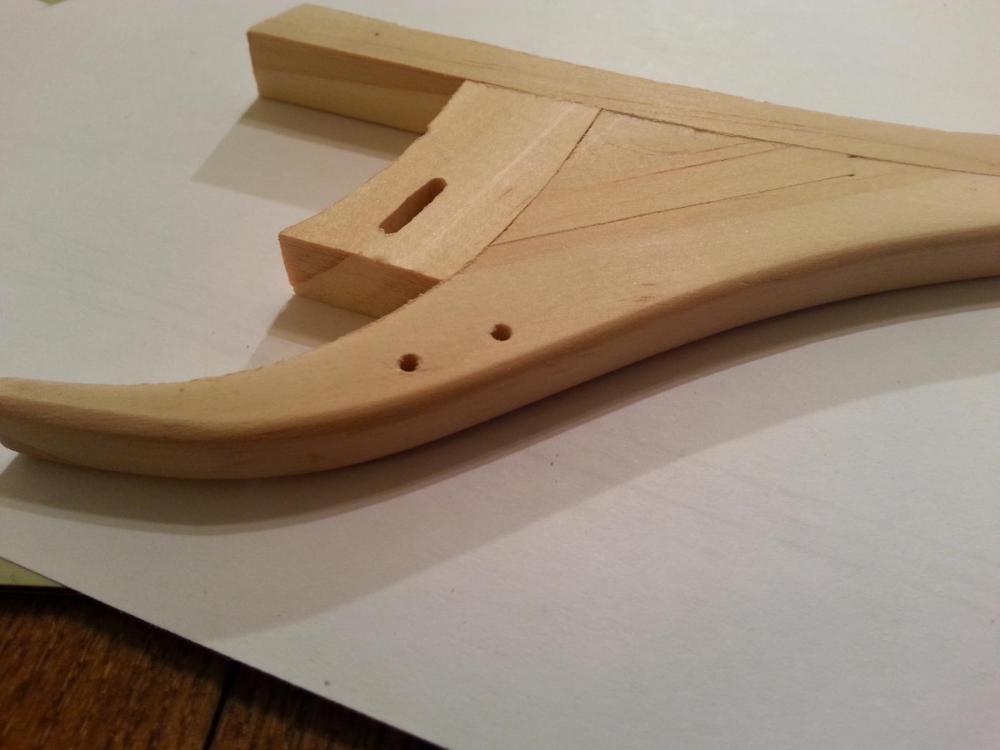-
Posts
75 -
Joined
-
Last visited
Content Type
Profiles
Forums
Gallery
Events
Everything posted by timboat
-
Thanks! A lot of interesting information guys. Some stuff I didn't think about. I have the Blandford book but no information regarding sweep stowage. I prefer to look at things from a practical point of view. To combine ya'll ideas they could have used the yard arm tackles (or even the stud sail lifts????) to lift the sweeps in the middle and use guidelines threaded through the sweep port to guide the sweep in. I don't think they would let them fall in the water and pulled up to the sweep port. The Blandford or ships like her had sort of a spar deck, but since the extra spars and boats were stowed there I can only imagine a few sweeps being stowed there? Were they stowed on the quarter deck aft of the helm? There seems to be quite a bit of room up there. Interesting enough I haven't found a 6th rate frigate with sweep ports that had a light box on the quarterdeck. Even the Pandora didn't have a lightbox. Or were they secured to the shrouds horizontally like the fish davit? Or even secured to the chain plates of the channels? I actually only know of one model that shows the sweeps being deployed but none that show where they were stowed, which is kind of ironic since quite a few 6th rate frigates in the 18th century had sweep ports. Edit: It seems the Trincomalee has sweep ports with a lightbox on the quarterdeck.
-
So...they would take these long oars, maneuver them inside and around the hot, cramped and short berth deck with the masts, pumps, ward rooms, capstan and bitts, and stick them through the sweep ports? That sucks. I would imagine they did not do this very often at all. So they would stow them somewhere on the berth deck? Suspended from the gun deck beams? On the bulwarks? On the berth deck?
-
I'm making a 3d model of a galley frigate based on the HMS Blandford. Seeing as the ship was a galley and there's plenty of paintings showing galley frigates using sweep I was wondering where were the sweeps stowed when not in use. I imagine some were stowed on the gallows along with the spares but I can't image all of them being stowed there. And how did they put them threw the sweep doors? From the outside or the inside? Any idea? Thanks.
-

location of stud sails (stuns'l) when stowed
timboat replied to timboat's topic in Masting, rigging and sails
I got Lees' Masting and Rigging of English Ships of War which is $70 well spent. But it brings me back to a concept I just can understand. I'm rigging my 3d model ship and it seems regardless of how hard I try or any book I can find some lines rub up against the wood inside of lubber's hole of the fighting platform. It also tangles inside of the shrouds. Was it ok if the lines rub up against wood as long as it was at a shallow angle? Also would there have been a piece of wood like a bee block or something that the lines rubbed on inside of the shrouds? -

Sail design for 18th-century longboat?
timboat replied to Cathead's topic in Masting, rigging and sails
Wow, really nice. I have a question. I'm making a 3d model of a 20 gun galley frigate circa 1719 and at some point, the boats for it. Would this be the typical rigging of the ship's pinnace? -

location of stud sails (stuns'l) when stowed
timboat replied to timboat's topic in Masting, rigging and sails
I guess I meant 6th rate ships from the early 18th century. Thanks for the suggestions guys. -

location of stud sails (stuns'l) when stowed
timboat replied to timboat's topic in Masting, rigging and sails
Does anyone know where I can find a pdf of the rigging of a ship from 1719? Maybe even "Seventeenth Century Ship Rigging" by Anderson? Thanks. -

location of stud sails (stuns'l) when stowed
timboat replied to timboat's topic in Masting, rigging and sails
Thanks so much for the information. I especially like the old books. So much knowledge and history. So it seems there is a general agreement the stunsl sails were kept bent to their respective yards and stored below, probably in the sail room. Awesome, this is what I needed to know. -

location of stud sails (stuns'l) when stowed
timboat replied to timboat's topic in Masting, rigging and sails
Hey guys, thanks for all of the input. I really appreciate ya'll knowledge. I've learned quite a bit. I'm afraid though I didn't do a good job asking my question. To rephrase, where were the sails for the top and lower stunsl's stowed when not in use? Were they kept bent to the yards? I'm getting the impression the sails were unbent from the yards and stowed down below and the yards were secured to their respective boom. In the event they wish to set the stunsl's, they brought the sails up to the deck and brought down the yards to bend them accordingly, then hauled them up. -

location of stud sails (stuns'l) when stowed
timboat replied to timboat's topic in Masting, rigging and sails
So do you think they unbent the sails from the stunsls yards and stowed them below? I can see the lower stunsls sails being stowed somewhere else than the lower booms since they're so close to the water, but do you think it's probable that some would leave the stunsls topsails bent to the yard, furled them and secured them to the course yards? -
Where would the stuns'ls be stowed on a 6th rate man o war from the early 18th century? I would also assume this includes the yard as the sails would be kept bent to them. I'm going to guess the lower sails were secured somewhere near the fore and main channels along with the stuns'ls lower booms and the upper stuns'ls were secured somewhere on deck or maybe even secured on the fore and main course yards. This is for my 3d ship I'm currently working on...
-
Nice work! Could this sloop represent a typical sloop from the early 18th century?
- 306 replies
-
- armed virginia sloop
- Patrick Henry
-
(and 2 more)
Tagged with:
-

Uniforms of the Royal Navy and Marines circa 1724?
timboat replied to timboat's topic in Nautical/Naval History
Charles Johnson's book is a wealth (or should we say a "treasure chest"?) of knowledge and insight in to the lives of pirates. I'm currently listening to the audio book on youtube. I found the story of Mary Read to be very interesting. It's a shame movie makers are so focused on making lame movies with explosions and lens flares instead of stores like Mary Read or even Sam Bellamy. That being said, I realize his book is based on his research and point of view, and my not include evidence of them wearing sashes if they did. This is just a theory of mine on a practical reason why they would have worn them. I'm really curious about this painting of Blackbeard and Maynard by Jean Leon Gerome Ferris, who is known for historical paintings. Even though it was created in 1920 it is very accurate. The Royal Navy uniforms are accurate being made of common shoes, stockings, breeches, period accurate waist coat and frock coat. Blackbeard himself is wearing normal shoes contrary to cavalier boots that are usually depicted, slops and a frock coat. I'm very curious where Ferris got the idea to paint a sash. -

Uniforms of the Royal Navy and Marines circa 1724?
timboat replied to timboat's topic in Nautical/Naval History
They wore sashes to wipe the blood off their sword blades before they put them back in the scabbards. Long time ago I watched a youtube video on medieval sword myths that made a lot of sense. One myth being knights stabbing the sword into the ground to pray. He pointed out why would a knight take a sword with a sharp edge, the same sword he uses to defend himself, and stab it into rocks, sand and dirt. He also pointed out they wouldn't take a sword blade full of blood, which is salty and corrosive to steel, and stick it back in their scabbards, which were made out of wood. The blood not only would rust the blade it would dry like glue and make the sword stick in the scabbard. So they would use a cloth or a rag to wipe the blade off first. Made a lot of sense to me, so I filed that away. Last Halloween my office dressed up as pirates and I took the practical approach to my attire. Wondering why pirates wore sashes I came to the conclusion it was to clean their cutlasses before they put them back in the scabbard. Other cultures and militaries of that time, including Samurai, sometimes wore sashes too. I guess after militaries wearing them for so long they became more of a decoration than a necessary item with different colors to signify different units or ranks. I guess you could say it was a form of a belt, but why didn't they use a normal, leather belt like everyone else? And while Hollywood may have made the imagine of pirates with sashes popular, I would imagine Hollywood got this idea from somewhere. At least this is my theory. -
I'm making a 3d model of a fictional 6th rate from around 1724 called the HMS Persephone, built to the 1719 establishment. The original taffrail has always gave me problems and to be honest looked rather out of place, so I made a new taffrail. I also wanted to capture the early 1700's style in the silhouette of the taffrail. As for the transom later I plan on adding carvings of Persephone, Zeus, Hades and a few angle babies. I'm concern it doesn't look historically accurate since I couldn't find any ships that look like this. What do ya'll think?
-

Uniforms of the Royal Navy and Marines circa 1724?
timboat replied to timboat's topic in Nautical/Naval History
Thanks for the info! Here a little trivia that I'd like to run by ya'll. Why did pirates, Samurai and some military from the old days wear specifically red sashes? -

Uniforms of the Royal Navy and Marines circa 1724?
timboat replied to timboat's topic in Nautical/Naval History
Thanks guys for your help! So it seems generally officers wore blue frock coats with gold edging and lacing, and tricorn hats. Marines wore red (or blue?) simple frock coats with tricorn or the funny acorn hats, and of course their musketry equipment. -
I'm interested in making 3d models of British Sailors and Marines from around 1724. Does anyone have any references? I know there was no set standard for the Navy before 1748 but I image it was very similar to that but tailored in early 18th century fashion. I'm sure the sailors wore descent clothing but nothing special like the officers. The only real reference I've found was the Blackbeard painting with Maynard. How about the Marines? I've only been able to find fragments of what they wore.
-
I have actually learned a lot since I've first posted my question. Ship building is very fascinating. All too often we as a society believe we are intellectually superior to past generations with our "smart phone", our cars that will automatically stop and landing probes on meteors speeding thousands of miles per hour through space. In reality our collective knowledge built by past generations is relative to our environment and our goals, but we are no more intellectually superior than past generations. Anyways...I meant copper bolts, not bronze. The information was fuzzy in my head at that point. I wish there was a simple diagram pointing out all the different materials in a cross section.
-
I'm making a 3d model of a British 6th rate ship circa 1720 and I have a question regarding the locations where trunnels were used verse iron/bronze nails. I know all (?) exterior planks were fasten to the frames by trunnels. Was there anything fasten on the outside using iron/bronze nails? Were the interior planks also fasten to the frames using trunnels? Were the deck planking fasten to the deck beams using trunnels or iron/bronze nails? I know the knees were fasten using large iron/bronze bolts. Where else were the iron/bronze bolts used to fasten stuff? Speaking of "iron/bronze" bolts, what's the difference between iron bolts and bronze bolts? Was it distinctive of different periods, areas of the ship, nationality, .etc? I'm sure the keel was fasten together using iron/bronze bolts. Is it safe to assume these were capped with false trunnels? I know this is a lot of questions, but it seems there's just isn't a one stop place for all the answers. Thanks!
-
It likes to keep an edge. I'm concerned about shrinkage though. It seems the gaps in my joints are getting wider. Either that or I'm getting better at making joints and I'm noticing my the poor quality of my previous work. I think it's affecting my allergies too. If I had the money and the dedication I would get better wood but at this point I think Pine will work for me.
-
I'm from Central Texas. Were you Navy? The Pine I'm using isn't the lumber kind. It's the mold/trimming pine found in the board/slant section of Lowe's. It doesn't have any sap and very, very few knots. In fact if I recall only one board had a knot in it when I was looked at them in Lowe's. So far I like it besides the visually high contrasting grain.
-
Thanks guys for all of your suggestions. I want to avoid expensive wood right now since I'm not really serious about it right now. I figure I would make the keel and frame and reevaluate my desire to build a ship model. At that point I'll look into more expensive woods that are not readily available in my area. Until that point I'm stuck with poplar and pine from Lowe's hardware store and basswood. Poplar doesn't sand or cut well. Pine does and it feels studier and stronger which I enjoy because it's easier to make rabbet joints but the oversized grain is very obvious. I got some basswood from hobby lobby but it was expensive. It was just as fuzzy as poplar but I feel poplar was stronger. I saw though bass wood bends easily. So right now I'm leaning towards pine. Is there any advice ya'll can give me about pine? At least when it comes to framing and the keel?
-
Hi everyone, I'm new to wooden ship building. I've been doing some 3d stuff but I want to try my hand at the traditional method. I want to make an 1:48 admiralty model of a sister ship of the HMS Pandora. I know that's above a beginner but I'm willing to give it a shot. I don't know what wood I should start out with. I've played around making a stern post out of poplar from Lowe's but I found poplar is too "fuzzy". So I got a piece of pine from Lowe's and I found I can work it better than poplar but the grain doesn't look right. (ok, obviously I'm not going to pick the boards at Lowe's with knots) Lowe's has red oak but I know that's not a good option for model ship building. I'm going to check Hobby Lobby and see if they have Boxwood. I want to keep it cheap for now since I'm just playing around with the idea of making a model. Any opinions or suggestions?
About us
Modelshipworld - Advancing Ship Modeling through Research
SSL Secured
Your security is important for us so this Website is SSL-Secured
NRG Mailing Address
Nautical Research Guild
237 South Lincoln Street
Westmont IL, 60559-1917
Model Ship World ® and the MSW logo are Registered Trademarks, and belong to the Nautical Research Guild (United States Patent and Trademark Office: No. 6,929,264 & No. 6,929,274, registered Dec. 20, 2022)
Helpful Links
About the NRG
If you enjoy building ship models that are historically accurate as well as beautiful, then The Nautical Research Guild (NRG) is just right for you.
The Guild is a non-profit educational organization whose mission is to “Advance Ship Modeling Through Research”. We provide support to our members in their efforts to raise the quality of their model ships.
The Nautical Research Guild has published our world-renowned quarterly magazine, The Nautical Research Journal, since 1955. The pages of the Journal are full of articles by accomplished ship modelers who show you how they create those exquisite details on their models, and by maritime historians who show you the correct details to build. The Journal is available in both print and digital editions. Go to the NRG web site (www.thenrg.org) to download a complimentary digital copy of the Journal. The NRG also publishes plan sets, books and compilations of back issues of the Journal and the former Ships in Scale and Model Ship Builder magazines.





